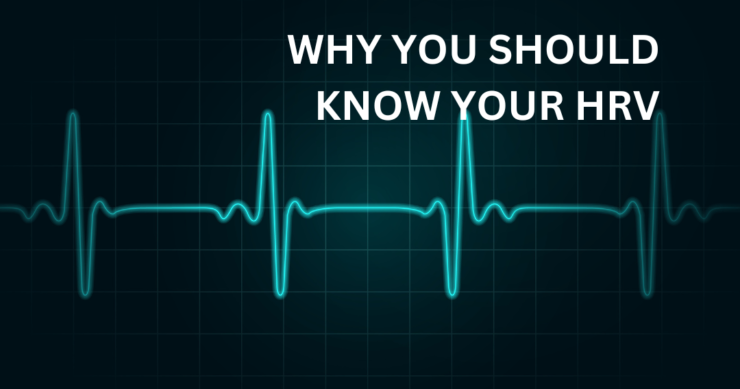Why You Should Know Your HRV

I’ve been mentioning heart rate variability a lot lately, especially on podcasts, in the context of it being an important health metric. So, I think it’s a good idea to take a closer look in terms of what this is all about.
Heart Rate Variability (HRV) is a measure of the variation in time between each heartbeat, and this is under the control of the autonomic nervous system (ANS). Importantly, and this is the take-home message, it is an indicator of the balance between the sympathetic and parasympathetic branches of the ANS. The sympathetic nervous system is often termed the “fight or flight” mechanism, which reacts to stress and prepares the body for a quick response, while the parasympathetic nervous system is often considered the “rest and digest” system, promoting relaxation and recovery.
HRV is considered a significant marker of physiological resilience and behavioral flexibility, reflecting an individual’s capacity to adapt effectively to stress and environmental demands. A higher HRV indicates a greater ability of the individual to withstand stress and is generally associated with good cardiovascular fitness and a healthy heart. Conversely, a lower HRV is associated with stress, fatigue, and even an increased risk for various cardiovascular diseases.
Understanding HRV
The heart does not beat with the regularity of a metronome. There is constant variation in the time interval between heartbeats. This variability is normal and reflects the body’s ability to respond to a variety of physiological and environmental stimuli. For instance, during inhalation, heart rate tends to speed up slightly, while during exhalation, it slows down. HRV captures this subtle dance between the heart rate and the breath, as well as other factors.
Health Correlations
HRV is linked with a number of health outcomes. It has been used as a predictive marker for morbidity and mortality in various cardiac conditions. It is known to be affected by age, with HRV typically decreasing as people get older, reflecting the natural decline in ANS flexibility. Lower HRV has been associated with increased risk of cardiac events, like myocardial infarction, and can be an indicator of other health issues, including chronic stress, anxiety, and certain inflammatory conditions.
Mental health can also impact and be reflected by HRV. For instance, conditions such as depression and anxiety have been associated with reduced HRV. Additionally, higher levels of stress and poor sleep quality are also correlated with lower HRV scores.
On the flip side, a higher HRV is related to good cardiovascular function, lower stress levels, and even improved cognitive function. It suggests a robust ANS and a healthy balance between its sympathetic and parasympathetic branches. Athletes, for example, often have a high HRV due to their high levels of fitness and the positive effects of regular, balanced exercise on the nervous system.
Measuring HRV
HRV can be measured with a heart rate monitor or other wearable devices that capture heartbeat data. My readings come from my Oura ring, but it looks like more and more wearables are providing this information.
Improving HRV
There are several strategies that individuals can use to potentially improve their HRV and, by extension, their overall health and well-being.
- Exercise: Regular physical activity is one of the most effective ways to improve HRV. However, the key is balance; while moderate exercise can enhance HRV, excessive training without adequate rest can lower it, reflecting the strain on the body.
- Stress Management: Techniques such as deep breathing, meditation, yoga, and mindfulness can increase parasympathetic (rest and digest) activity and may boost HRV.
- Quality Sleep: Improving sleep hygiene and ensuring adequate sleep duration can have a significant positive impact on HRV. The restorative process during sleep is crucial for maintaining a healthy nervous system.
- Reducing Stimulants: Reducing intake of stimulants like caffeine, which can induce a sympathetic response, may help in improving HRV over time.
- Hydration: Proper hydration is essential for cardiovascular health and function, which can, in turn, affect HRV. Hydration has the added benefit of improving metabolism.
- Social Connections and Laughter: Positive social interactions and laughter have been shown to improve mood and may lead to an increase in HRV, reflecting reduced stress levels.
- Mind-Body Techniques: Other practices like tai chi and qigong that integrate physical movement with breathing and meditation can also be beneficial. I personally found a significant improvement in my own HRV using the Apollo wearable device.
- Biofeedback and Neurofeedback: These techniques help individuals learn to control physiological processes that are usually involuntary, including HRV. By using sensors that provide information about heart rate, individuals can learn to increase their HRV through biofeedback.
- Cold Exposure: Brief exposures to cold, such as cold showers, can potentially increase HRV along with providing other health benefits
Heart Rate Variability is an interesting and valuable biometric that serves as a window into the functioning and balance of the autonomic nervous system. It represents an intricate interaction between our cardiovascular system and various physiological and environmental factors. As a marker of overall health, HRV has gained considerable attention not only among researchers and clinicians but also among athletes and individuals seeking to optimize their well-being. This is why we refer to it regularly in our various platforms.
HRV’s potential as a personal health marker lies in its ability to be modified with lifestyle changes. By understanding what influences HRV, one can implement strategies to improve it – engaging in regular, balanced exercise, managing stress, prioritizing sleep, and practicing good nutrition, among others. While the endeavor to enhance HRV is an individual journey, the underlying principles for improvement are universal and are intertwined with the broader aspects of a healthy lifestyle.
Moreover, with the advent of wearable technology that can track HRV, individuals have more tools at their disposal to monitor their health in real time. This information can empower people to make informed decisions about their day-to-day habits and overall health strategies. Nonetheless, it’s important to approach HRV as one piece of the health puzzle rather than a standalone indicator. It’s best considered in the context of other health markers and symptoms.
Improving HRV is not just about enhancing a single physiological parameter; it’s about fostering a holistic balance within the autonomic nervous system, which has far-reaching benefits for physical health, mental well-being, and overall quality of life. Whether one is recovering from stress, striving for peak athletic performance, or simply seeking a longer, healthier life, paying attention to HRV can be a valuable part of one’s health optimization toolkit.













